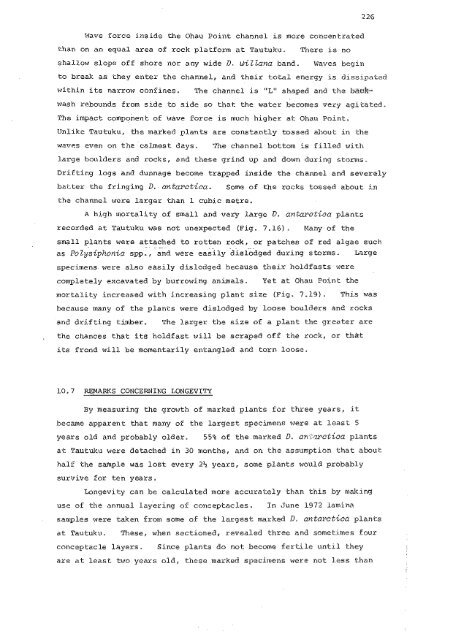A biological study of Durvillaea antarctica (Chamisso) Hariot and D ...
A biological study of Durvillaea antarctica (Chamisso) Hariot and D ...
A biological study of Durvillaea antarctica (Chamisso) Hariot and D ...
Create successful ePaper yourself
Turn your PDF publications into a flip-book with our unique Google optimized e-Paper software.
Nave force inside the OhC!m Point channel is more concentrated<br />
than on an equal area <strong>of</strong> rock platform at Tautuku.<br />
shallow slope <strong>of</strong>f shore nor any wide D. wiZlana b<strong>and</strong>.<br />
There is no<br />
Waves begin<br />
to break as they enter the channel, <strong>and</strong> their total energy is dissipated<br />
within its narrow confines.<br />
The channel is "L" shaped <strong>and</strong> the<br />
wash rebounds from side to side so that the water becomes vexy agitated.<br />
The impact component <strong>of</strong> wave force is much higher at Ohau Point.<br />
Unlike Tautuku, the marked plants are consta.ntly tossed aJ)out in the<br />
waves even on the calmest days.<br />
The channel bottom is filled tllit.h<br />
large boulders <strong>and</strong> rocks, a.nd these grind u.p <strong>and</strong> dONn during storms"<br />
Drifting logs <strong>and</strong> dunnage become trapped inside the channel <strong>and</strong> severely<br />
bat.ter the fringing' D. <strong>antarctica</strong>.<br />
the channel \Vera larger than 1 cubic metre.<br />
226<br />
Some <strong>of</strong> the rocks tossed about in<br />
A high mortality <strong>of</strong> small <strong>and</strong> very large D. <strong>antarctica</strong> plants<br />
recorded at Tautuku was not unexpected (Fig. 7.16),<br />
Many <strong>of</strong> the<br />
small plants were attached to rotten rock, or patches <strong>of</strong> red algae such<br />
-- -- ---- ~ - - ---<br />
as Po~ysiphonia spp., <strong>and</strong> were easily dislodged during storms. Large<br />
specimens were also easily dislodged because their holdfasts ,\lere<br />
completely exca.vated by burro\'ling animals.<br />
Yet at Ohau Point the<br />
mortality increased with increasing plant size (Fig. 7.19),<br />
This was<br />
because ma.ny <strong>of</strong> the plants \'lere dislodged by loose boulders <strong>and</strong> rocks<br />
<strong>and</strong> drifting timber.<br />
The larger the size <strong>of</strong> a plant the greater are<br />
the chances that its holdfast will be scraped <strong>of</strong>f the rock, or that<br />
its frond will be momentarily entangled <strong>and</strong> torn loose.<br />
10.7 ~RKS CONCERNING LONGEVITY<br />
By measuring the gro"lth <strong>of</strong> marked plants for three years, it<br />
became apparent that many <strong>of</strong> the largest specimens ",ere at least 5<br />
years old <strong>and</strong> probably older. 55% <strong>of</strong> the marJ{ed D. <strong>antarctica</strong> plants<br />
at Tautuku were detached in 30 months, <strong>and</strong> on the assumption that about<br />
half the sample was lost every 2~ years, some plants ",ould probably<br />
survive for ten years"<br />
Longevity can be calCUlated more accurately than this by making<br />
use <strong>of</strong> the annual layering <strong>of</strong> conceptacles. In June 1972 lamina<br />
samples ~'lere taken from some <strong>of</strong> the larg-est marked Do antai'ctioa plants<br />
at Tautuku. These, when sectioned, revealed three <strong>and</strong> sometimes four<br />
concepts.cle layers. Since plants do not become fextile until they<br />
are at least 1:\-10 years old, these marked specimens were not less than
















